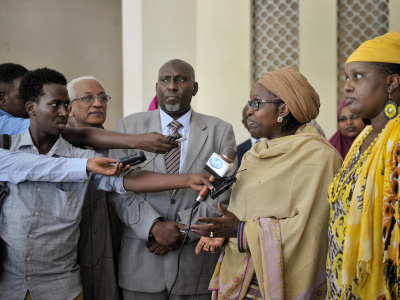
From ambition to uncertainty: Gender equality in the EU’s new Global Europe instrument
Authors
Fearing the further weakening of gender equality globally, Sara Gianesello, Mariella Di Ciommo, Katja van der Meer and Sophie Desmidt argue that the EU must show stronger leadership – especially in its new Global Europe instrument.
This commentary is gender transformative. 
In July 2025, the European Commission presented its proposal for the 2028-2034 Multiannual Financial Framework (MFF), including a new Global Europe instrument to steer the EU’s external action. Negotiations will start soon, and one trend is already evident: gender equality risks slipping down the agenda of EU external action. At a time when other countries have already sidelined gender equality and women’s rights in policies and budgets, the EU must show stronger leadership.
A weakened EU financial backing for gender equality
The proposed €1.98 trillion MFF brings substantial restructuring and simplification in EU financing. The principal aim is to better align EU spending with its strategic priorities, such as competitiveness and strategic autonomy, security and defence, and migration. Within this, the proposed Global Europe instrument (GEI) commits €200.3 billion for external action and international partnerships – a 57% increase compared to current funding (in real terms). This is a bold move at a time when development aid is shrinking globally, although it will still have to survive harsh negotiations with member states and the European Parliament.
The European Commission also frames the next MFF as an opportunity to reaffirm Europe’s commitment to its common goals and values, explicitly referring to multilateralism, the Sustainable Development Goals (SDGs) and the Paris Agreement. On top of that, recital 47 in the proposed Global Europe regulation states that the implementation should be guided by gender equality, women’s and girls’ empowerment (GEWE), the prevention and combating of violence against women and domestic violence, and key policies such as Gender Action Plan (GAP III) – the EU’s core framework for promoting GEWE internationally.
While these commitments under recital 47 are welcomed, recitals do not carry the same legal weight as articles in EU legislation, and at the moment, the language around GEWE used in the articles is not as bold as the one used in the Neighbourhood, Development, and International Cooperation Instrument (NDICI-Global Europe). More critically, it remains unclear how these commitments will be achieved and what resources will back them in practice.
A Global Europe instrument with no targets
Together with an effort to maximise flexibility, the most significant shift in the proposed Global Europe instrument is the removal of all binding targets for areas such as climate and environment, human development, and GEWE. The Commission instead proposes a ‘full mainstreaming’ approach, arguing that this will allow the EU to more swiftly adapt and respond to emerging priorities. However, article 10, dedicated to this new ‘full mainstreaming’, only provides general guidance and the approach isn’t fully articulated yet. Without clear targets, gender equality objectives risk dilution within broader programmes with reduced funding and more complex accountability.
The gender equality targets were never a silver bullet, but they helped to safeguard it from political whims.
The gender equality targets were never a silver bullet. They faced challenges, but they played the essential role of ensuring that gender equality remained part of EU programming, helping to safeguard it from political whims. Where political leadership was strong and the local environment allowed, the targets empowered the EU to meaningfully mainstream gender across multiple sectors, from digitalisation to global health.
GAP III’s legacy at stake
Already a decade ago, in its Gender Action Plan II, the EU committed to ensuring 85% of its new external actions have gender equality as a significant or principal objective. Its successor GAP III reaffirmed this target, and the commitment was locked into the NDICI-Global Europe. The NDICI-Global Europe actually took a step further and committed that at least 5% of new EU external actions must have GEWE as their primary objective, among those 85%. To reinforce this, the 2021-2027 programming guidelines required all EU delegations to design at least one action dedicated to promoting gender equality in each country.
The GAP III provided the EU with a comprehensive approach that included mainstreaming, targeted actions and policy dialogue. While a work in progress, our research shows that this approach was widely regarded as forward-looking and necessary by local gender advocates and committed policymakers. Further, mainstreaming gender equality in international cooperation has proven to enhance the effectiveness and sustainability of interventions. But it also needed targeted actions to maximise impact, particularly given the persistent challenge of securing dedicated funding for GEWE globally.
Gender financing in the midst of political backlash
Past commitments under the NDICI-Global Europe and its clear linkages with the GAP III provisions reflected a strong political will to keep gender equality at the heart of the EU’s external action. While that was never a ‘done deal’, this ambition now seems to be fading further.
Our research shows that political commitment to gender equality is crucial for the implementation of GAP III and the meaningful use of EU resources. The Global Europe framing will put that to the test even further, given the strategic dilemma it has to deal with: reconcile EU core interests and its commitments to sustainable development and values, including GEWE. The deprioritisation of gender equality in the EU’s external actions and funding instruments mirrors the rise of populist and anti-feminist rhetoric in some member states and abroad.
Rather than letting the values agenda slip further, the EU should close the gap between stated values and practical actions.
Efforts to promote Feminist Foreign Policies, including at the EU level, have dwindled in the face of harsher and more exclusionary politics and decreasing budgets. The EU faces difficult trade-offs in a context of global uncertainty, shifting power dynamics, and a stronger focus on national priorities. Yet, privileging economic interests over core values, such as gender equality and women’s rights, risks the EU’s credibility and reinforces accusations of double standards. Rather than letting the values agenda slip further, the EU should close the gap between stated values and practical actions.
Over the past decade, EU policies and commitments on gender equality have allowed for real progress – gains that should not be lost. GAP III in particular demonstrated strong political will, equipping the EU with an ambitious vision and a comprehensive three-pronged approach, while recognising women as key drivers of change.
The way ahead
Looking ahead, two key questions are key. First, how can the spirit and architecture of GAP III – with its mix of mainstreaming, targeted actions, and policy dialogue – be preserved in the new Global Europe instrument? And second, what are the implications of ‘full mainstreaming’ and how will it be realised in practice?
We will follow the negotiations with a view to addressing these questions; drawing on lessons from past experiences and good practices within EU programming, we can point to concrete ways of how financial and policy commitments can be aligned to secure concrete outcomes.







